I have had the pleasure of doing many overseas trips in the last few years, the details of which have appeared in various publications. Here is the first of a whole series about to come on this website.
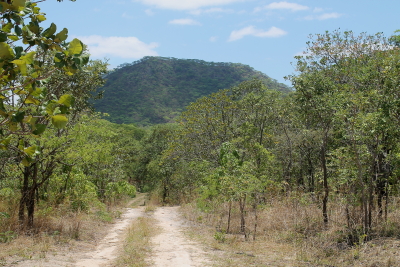
Dzalanyama Forest Reserve, Malawi 24/11/15
Malawi isn’t the most famous of African birding destinations. Before travelling there, I asked a few friends what it was like, and nobody could tell me. Yet, while birders have flocked at various times to South Africa, Kenya, Uganda and Namibia, it seems that they have all been missing out. Malawi is an absolute gem, and deserves to be given far more attention.
Furthermore, it is blessed with a number of practical benefits. For a start, it is politically safe and stable – no war has ever taken place on its soil. Secondly, the people are amazingly friendly, meaning that it genuinely earns its tourist epithet of “the warm heart of Africa.” Thirdly, it is a small country, only half the size of the UK, so travelling distances are relatively short compared, say, to South Africa. Transport, too, isn’t bad at all.
But hey, many a birder doesn’t care about warm hearts and kind roads. What about those things with feathers? It turns out that these are amazing, too. About 650 species have been recorded in the country, and Malawi’s position in south-central Africa means that there is a mixture of species from farther south and farther north. This is particularly important in terms of some very highly sought-after species of Afro-montane evergreen Forest. And Malawi manages to showcase highly localised species in all four corners. In the deep south, in particular, are some stunningly rare specials such as White-winged Apalis and Green-headed Oriole.
In this short account I will mention some mammals, too. Some classic “safari” mammals, such as Lion, Rhinoceros and Giraffe, are rare or missing, but Elephants and Hippos are present, along with a few Leopards and a wealth of other interesting stuff.
My visit was funded by Malawi Tourism and by Central African Wilderness Safaris (http://cawsmw.com/).
I arrived at Malawi’s capital, Lilongwe, on a November evening and, almost as soon as we had exchanged pleasantries, my guide Abasi Jana told me some great news. Tomorrow we would be off to Dzalamyana Forest. For many years I had heard about the large flocks of birds that wander this forest, many of which are rare and localised. I had been advised to include the place in my book “The World’s Top 100 Birding Sites” as one of the finest patches of miombo woodland on the planet. Now I would be able to experience its bird wonders for myself.
There is a proviso, though, about birding in miombo; it is famously hit and miss. Find a roaming bird flock and you will strike gold; if you cannot connect, it can be disappointing, even dull. Well, for us the tension lasted all of five minutes. Within a few yards of the entrance gate, on our very first stop, Abasi suddenly stood to attention. “I can hear Pale-billed Hornbill,” he declared. We had barely begun and a scarce miombo endemic was close at hand.
Miombo is woodland dominated by trees known as Brachystegia, characteristic of poor soils. Here it was sandy and the trees were thin-trunked and a little stunted. Even so, it took us a little while to get a view of the Hornbills, one of which was perched on a treetop in the sun. What we didn’t realise, concentrating on our quarry, was that birds were quietly gathering, almost at our feet. Within moments a movement snatched our attention no more than a few metres away. To my delight I recognised it instantly from my homework – a Souza’s Shrike, smart with a black facial mask, clean white breast and a broad white bar across its shoulders. Shrikes often use high perches, but this rarity is a denizen of middle levels of the forest.
Within minutes the trees around us were buzzing with birds uttering quiet calls, and the excitement mounted. In this forest, every flock contains a different range of birds; what would we see next? The answer was a delightful flycatcher-like bird with smart black-and-white wings and a vivid apricot-yellow breast, called a Yellow-bellied Hyliota, a suitably exotic name for this exotic place. These mites foraged in the treetops along with a group of African Paradise-Flycatchers. The latter are the sorts of birds that forever adorn travel brochures, with their extraordinary long streaming white tails more than doubling their length. They were stunning, not rare, in contrast to their near-neighbours in a small tree, a pair of very small, warbler-like Green-capped Eremomelas – another miombo special.
There were so many other birds present that it was difficult to concentrate on them all. So, I was glad, after twenty minutes or so, when the activity began to die down slightly.
“We have been lucky,” said Abasi, quietly. And then he said “Ah, Stierling’s Woodpecker”.
The adrenaline began to flow again. Stierling’s Woodpecker is a real rarity and Dzalamyana is probably the best place in the world to see it. Excitement mixed with sheer joy as we enjoyed point-blank views of no less than two pairs of the smart, green-backed medium-sized woodpecker with a black face-mask. No sooner had we basked in seeing these than another flock formed around us and time stood still. I won’t list all the birds – Retz’s Helmetshrike, Red-faced Crombec and Striped Pipit stood out among another twenty or so species seen.
The miombo was treating us kindly today. Or was it simply showing off? When we ran into a third flock, no more than a few hundred metres along the track, we were suitably convinced it was the latter. And, true to form, this flock contained yet a different group of birds. This time the highlight was a pair of African Spotted Creepers. I had nurtured a desire to see this oddity, mainland Africa’s version of the treecreeper, for many years. In contrast to other treecreepers this intricately-plumaged character builds an open nest, a wondrously concealed cup. The eggs of the African birds are turquoise, while the related birds in India lay grey eggs – answers on a postcard as to why.
While the Spotted Creeper is, admittedly, very much a birders’ bird, our next sighting was a species that could bring tears to the eyes of anybody at all. The continent of Africa is garlanded with a family of glitteringly coloured birds that drink nectar, the Sunbirds (Nectariniidae), the Old World equivalent of the hummingbirds. Curiously, despite their diet they seldom hover, instead using perches thoughtfully provided by nectar-producing plants. Anyhow, everybody has their favourite, but one species invariably in the top five is Anchieta’s Sunbird. This gem is beyond gorgeous: it has an iridescent blue head and a brilliant yellow breast. So far, nothing special for a sunbird – however, it looks as though somebody has then dug a dagger into the top of the breast, and a river of crimson blood has flowed down the bird’s front. The effect is startling. It’s a bird to send a shiver down the spine.
And of course, it is a miombo special.
Dzalanyama had woven its magic, and this after a late start (owing to my incoming flight) and an early finish. Before retiring to dinner, Abasi suggested we should call in briefly at Lilongwe Nature Sanctuary, a tiny (150Ha) oasis in the middle of the capital, just west of the City Centre. It is a slightly scruffy area of scrub and woodland alongside the Kingadzi River. In our short hourly sojourn, we managed to see a couple of its special birds, and these could hardly have been more contrasting: the plump and dark-plumaged African Black Duck and the minute, overripe-cherry coloured Red-throated Twinspot.
As the sun began to set and dinner was prepared in the very comfortable Heuglin’s Lodge, in Lilongwe’s diplomatic quarter, Abasi and I went through our checklist. As we did so, new birds in the spacious garden kept on interrupting the tally, but eventually we came to a total of 110 species.
“That’s good,” Abasi declared. “But I want to get to 300 in the next few days.”
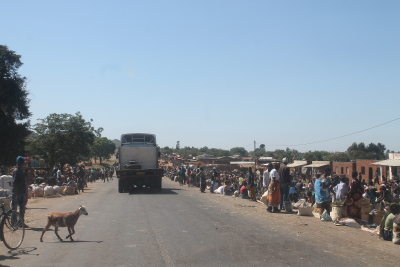
Market on Malawi/Mozambique border road
Four hours south of Lilongwe, Malawi’s current capital city, lies Zomba, the former and first capital of the country. It was the centre of British rule before Malawi existed as an entity, and was much beloved in colonial times because of its relatively cool climate. Some of the buildings in the city are distinctly grand. As far as birding is concerned, Zomba Botanic Gardens is a good spot, but the main attraction is the fabulous Zomba Plateau, a serious drive uphill from the town. Here the amazing Sunbird Ku Chawe Inn is perched on a hilltop over the surrounding plain, giving one of Malawi’s finest views.
You can walk from Ku Chawe to patches of the Plateau’s remnant native forest. Only small and diminishing amounts remain of what was once a vast swathe of Afro-montane wilderness stretching across southern Malawi and into Mozambique. Very little forest remains, which is a tragedy of huge proportions. It does, though, mean that it is easy to reach very good bird habitat stuffed full of glorious species that can be hard to find elsewhere.
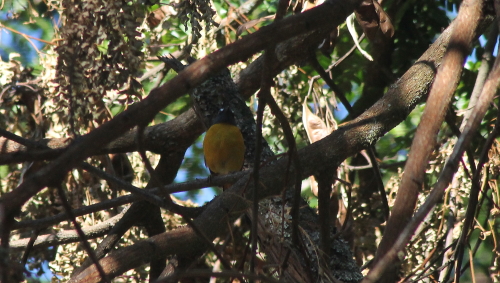
White-starred Robin, Zomba Plateau, Malawi 25/11/2015
We tried the area around Williams Falls first. It was brimming with birds, even in the afternoon. A White-starred Robin stood to attention on a low branch, a Livingstone’s Turaco flew across the water and several species of skulking Greenbuls eventually gave themselves up. A pair of the recently split Malawi Batis – not quite endemic to the country – crept around the canopy, together with the localised White-eared Barbet, while Evergreen Forest Warblers called incessantly from the undergrowth, defying us to see them (we did). Other good species here included the Blue-spotted Wood Dove and the Forest Double-collared Sunbird. In some ways, the moment I remembered best, though, was hearing a decidedly familiar voice among the strange ambience. After a few minutes thought I realised that it was a Garden Warbler, a sweet-voiced skulker that breeds in Europe. Here it was on a mountaintop in sub-Saharan Africa.
The biggest prizes in this corner of Malawi tend, though, to be those long-tailed, warbler-like birds known as Apalises. Williams Falls provided us with one of the rarities, the Yellow-throated Apalis, a small, short-winged sprite with a neat black bar across its chest, together with lemon-yellow belly and, of course, throat. Recently split from the widespread Bar-throated Apalis, it is now probably Malawi’s only endemic bird, although there is nothing to stop it being found in nearby Mozambique.
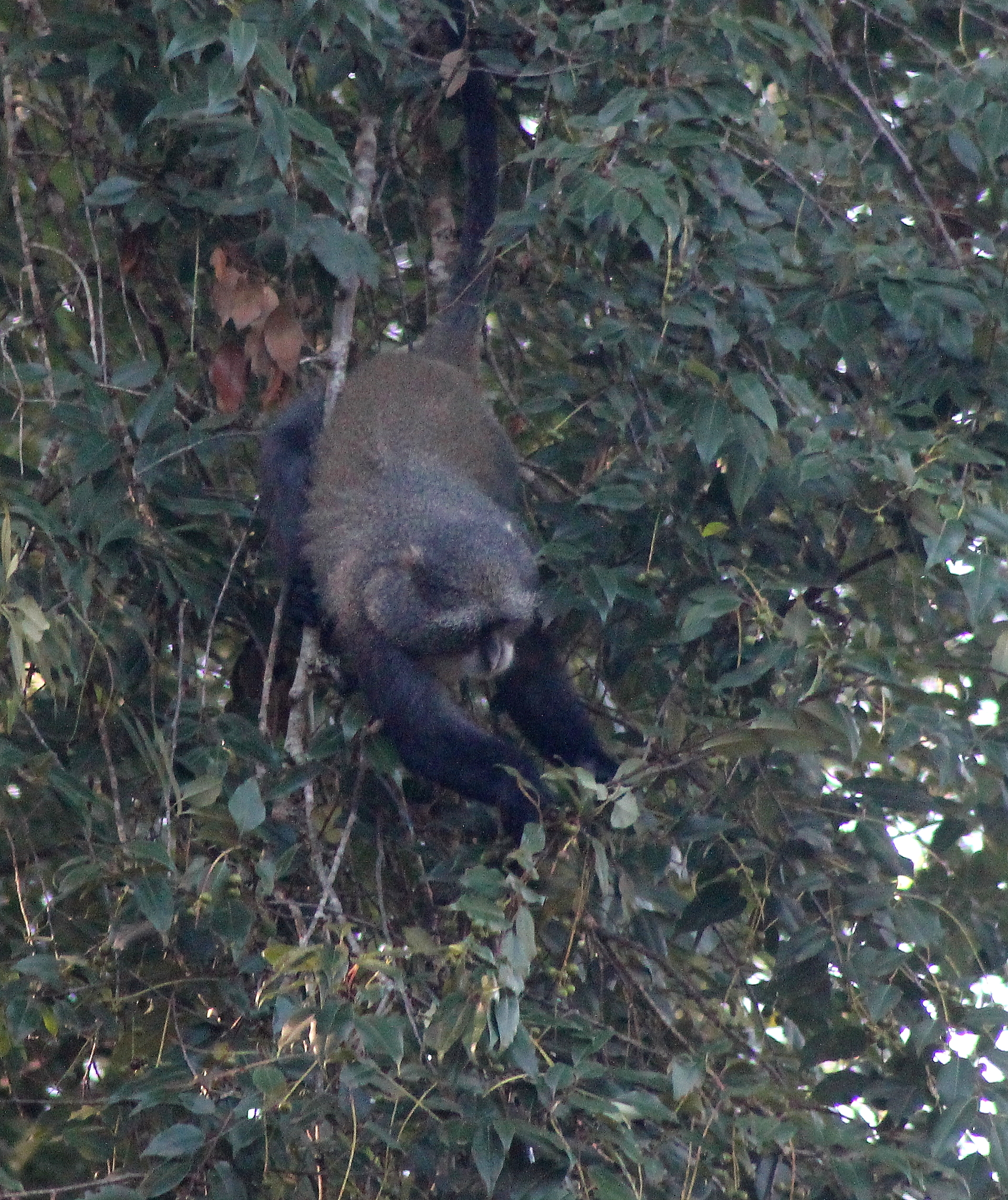
Blue Monkey, Zomba Plateau, Malawi 26/11/2015
Without being rude to such a special bird, Zomba’s other treasured Apalis is the one with true star quality. And for this one we made the pilgrimage to the private garden of a Dr Wilson, the first person to document the breeding behaviour of this rarity, the White-winged Apalis, by his back door. We chatted over tea and had a walk to the nearby Botanic Gardens, where good birds included Square-tailed Drongo and Forest Weaver (alongside many Yellow Baboons). However, beauty does not always come with reliability attached, and no Apalis showed. Dr Wilson, though, was an inspiration, his every sentence steeped in knowledge of the local fauna and flora.
Abasi, unbeknownst to me, had a Plan B, and as soon as we left Zomba and drove up towards the plateau, he stopped in a lay-by and directed my eyes to a treetop. Here, resplendent, was a pair of the fabulous White-winged Apalis – black above, mustard-yellow below, with a white throat and, of course, a large white patch on the wing contrasting with black. Words don’t convey its smartness, but words can convey the relief at finding it.
At dawn the following day we tried the forest around Ku Chawe itself. Almost straight away we ran into another of the big specials – or at least, we heard it. Now, nobody would ever put a Thyolo Alethe in a brochure to attract tourists, but this brownish, skulking Robin-like bird is another of the suite of special birds only found in southern Malawi and northerm Mozambique. It led us a merry dance, and actually had the last laugh because, as we finally set eyes upon its diminutive form in the undergrowth shadows, we found that we were standing on an ants’ nest. The owners weren’t happy and yes, they did bite. The irony was that, as we saw the Thyolo Alethe, the main constituents of its diet were attacking us.
Having brushed off the last of the ants, we were able to enjoy several more good sightings. Both Brown Snake-Eagle and Ayres’ Hawk-Eagle flew over, while in the bushes the very smart, bright sprite Yellow-throated Woodland Warbler foraged above our heads. However, personally my two favourites of the morning were a pair of delightful Estrildid finches, a Red-faced Crimsonwing (you can guess the plumage) and a pair of Green Twinspots feeding on the ground. The latter were tiny, grass-green with smart black bellies decorated with even smarter white spots. Both of these are serious Afro-montane forest birds, specials to make the local birders salivate.
It was time to head south, past Blantyre towards the settlement of Thyolo, where the fragments of forest are even smaller and more threatened. The summit of the mountain is denuded, but on the Satemwa Tea Estate there are small, private patches of this precious habitat. Happily, our immediate destination was accommodation at the stately Huntingdon House, where guests bask in the delightful opulence of this 1920s lodge. The spacious garden was bedecked with old trees and planted shrubs, one of which was flowering and attracting hordes of sunbirds. To be honest, after lunch I needed to be dragged out birding from this heavenly haunt – and that is saying something.
Thyolo Forest offered, though, another opportunity to find some of the Afro-montane specials. The area is so tiny – it feels no bigger than a large garden – that the best birds can’t evade you forever, although they certainly try. One of our star birds made us sweat for some hours, but eventually Abasi spotted an African Broadbill perched in the canopy above. Broadbills aren’t spectacular, just plump songbirds with brown streaked plumage, but they have an otherworldly mien. The large head and broad bills are used for picking up large invertebrates, which they hawk on the ground after long periods of sitting and waiting motionless. They also build strange suspended nests. They are scarce forest birds in Africa.
The forest wasn’t short of more spectacular birds. Just inside the entrance was the nest of a Black Sparrowhawk, and once of twice the adults slipped to and from the platform, their upperparts coal-black, as the name implies. As much as these predators were unobtrusive, the local pair of Silvery-cheeked Hornbills just couldn’t keep quiet – the swish of these huge birds’ wings as they flew was loud and unmistakable. In addition, colour was provided by the Orange Ground-Thrush and by the localised Black-fronted Bush-Shrike. Large butterflies flitted around sunlit patches and a troupe of Blue Monkeys called, unseen, from the other side of the forest.
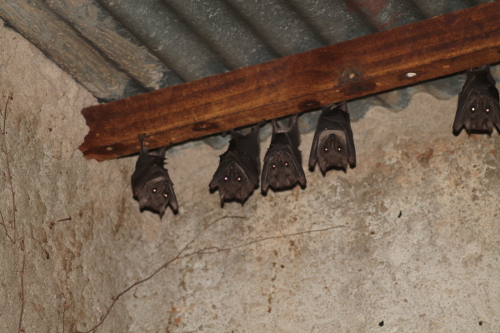
Harrison’s Soft-furred Fruit Bats, Huntingdon Lodge, Thyolo, Malawi 26/11/2015
As the sun began to set, we returned to the bosom of Huntingdon House and sipped cold beer before dinner. The other entrée was bats. It turned out that a colony of fruit bats lived in one of the house roofs, and that recently specialists had visited and identified them as Harrison’s Fruit Bats. About 50 of them were twitching and stretching not far above us, ready to set off on the night’s foraging.
The following morning, we were on a mission, to find what is arguably Thyolo’s most sought-after bird. It is easiest to find in the woods fringing the tea estate, rather than in the main forest patch itself. On a surprisingly chilly morning, though. it wasn’t playing ball, even if many other birds were: Black Cuckooshrike, Forest Weaver, Thick-billed Weaver, Violet-backed Starling and even a reprise of the dazzling White-winged Apalis. Breakfast came and went, tension rose, and we took the car to the far fringes of the Estate.
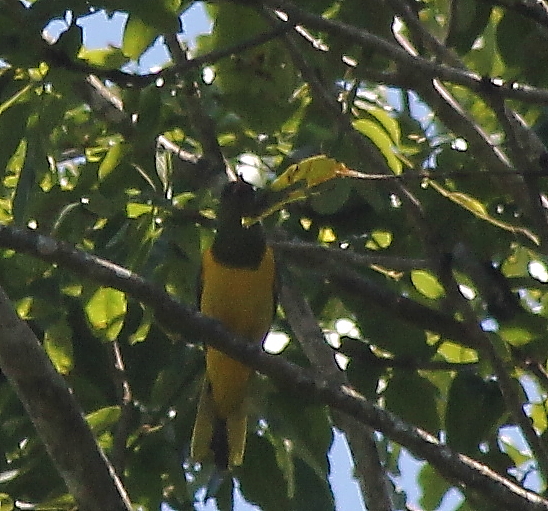
Green-headed Oriole, near Thyolo, Malawi 27/11/2015
Finally, Abasi said: “I hear it!” And the glorious, liquid call of an oriole floated across an agricultural field, from a distant patch of trees. The calls continued as we crept closer, breathlessly, until the birds were almost above our heads. And finally, a Green-headed Oriole finally showed itself. Its bright yellow underparts and neck-collar gave way to moss-green head and mantle, dark grey wings and bright red bill, a most arresting combination of colours.
I hadn’t realised at this point that the Oriole was effectively the last of the true specials that we were searching for. It was only after lunch, and more beer than I really needed, that Abasi asked me on the porch of Huntingdon House what I would like to do next. Freed from the need to look for anything specific, there could only be one answer to that question – Mount Mulanje.
The Mount Mulanje massif, an hour or so to the east of Thyolo, is the highest ground between Kilimanjaro and the Drakensberg, in South Africa, so it is serious hulk of mountain. It rears up as high as 2300m from the surrounding plain and reaches 3002m at Sapitwa, one of several high peaks. It dominates the skyline, even as far away as Zomba. It is the sort of mountain which draws you to it and asks to be climbed.
Since it was already afternoon, a full climb was out of the question, but Abasi assured me that we could follow a trail upwards until the light beat us. We set off from the hydroelectric plant into a huge, high-sided gorge, accompanied by the roar of the Big Ruo River. Having spent time in tiny forest fragments, here we were engulfed by trees cloaking large areas of hillside. I found myself utterly intoxicated with it all. Rather than simply strolling up the trail and balancing on the large hydroelectric pipes that formed part of the walkway, I began to race upwards, exhilarated. I wanted to burst into song. After an hour, I could have skipped all the way up, if Abasi hadn’t wisely stopped me.
It was just that Mount Mulanje is awesome. The forest seemed to brim with Silvery-cheeked Hornbills, dozens more birds called from the dense canopy, and far above us both Scarce and Black Swifts swept across the rocky crags with expert abandon. This was Malawi’s emerald forest, just as it must have looked like a few decades ago when the trees stretched as far as the eye can see.
We came down, but in a sense, I still haven’t quite come down to earth from this magical place.
On the way home it quickly got dark, and the journey became a little hairy. This is one of the most densely populated rural areas in the whole of Africa, many of whom were milling about beside the road. Nevertheless, our driver managed to miss every human being, and as a bonus we spotted both an African Hedgehog and a Cape Hare.
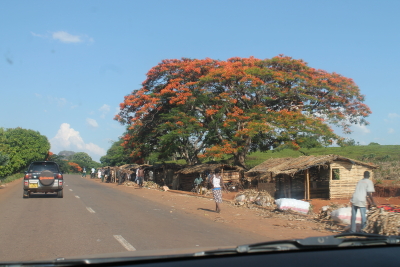
Malawi roadside scene (Mulanje), with flame trees 27/11/2015
The following morning, we paid a final visit to Thyolo Mountain where, after a long search, Abasi somehow spotted a Bar-tailed Trogon in the canopy. I was already full of admiration for my genial guide, but how he made out this individual in the greenery, perching typically still for a Trogon, I shall never know. The pair of Black Sparrowhawks treated us to a farewell food-pass, and after another superb breakfast we left Huntingdon House for the north. Our destination was one of Malawi’s most famous National Parks.
Liwonde National Park is situated along the banks of the Shire River, which flows down from Lake Malawi, via its sister Lake Malombe. This park encompasses habitat that chimes with most people’s idea of “Africa”, with its open country full of large animals and scattered thorny trees. It is said to have the densest population of Hippos in the whole of the continent.
The main approach to the park is across the Shire River by boat. Before we even got to the landing, however, progress was halted by a small herd of Elephants that lumbered across the road. These giants are also abundant in the National Park and immediate area; famously, they often swim across the river, holding their trunks high.
We soon took our first boat safari down the Shire. As you might expect with many an African wetland, there were masses of birds everywhere; you couldn’t turn your head without seeing something, be it an Osprey plunging into the river for a fish on one side or a Yellow-billed Stork patrolling the shallows the next. The main interest, though, as ever in Malawi, was in spotting the more unusual sights, such as the roosting White-backed Night-Herons close to the Lodge or, my favourite, seeing a flock of African Skimmers roosting on a sand-bank. The latter were soon disturbed by a high-spirited Hippo, which seemed to think that their sand-bar was a good short-cut from one feeding site to the next. Other good birds we saw on the boat trip included localised species such as Meeves’ Starling and Lilian’s Lovebird, as well as a mammalian special, the Greater Kudu.
You really wouldn’t want to fall out of a boat on the Shire. Quite apart from the astonishing density of Hippos, there seemed to be equal numbers of Nile Crocodiles in the water, too. Presumably, there is enough meat and aquatic vegetation hereabouts to keep them all happy.
Our accommodation was at the luxurious Mvuu (the Chewa name for Hippo) Lodge. The open-air restaurant on stilts overlooks the banks of the river, in a spot where game seems to lounge all day long. You can have a cold drink and watch Waterbuck, Warthog, Bushbuck, Impala and Yellow Baboon, as well as Hippos and Elephants. In the evening, as I would find out later for myself over a cold beer, you can see Pel’s Fishing Owl.
In the late afternoon we set off for a game drive close to the Lodge, which would culminate in a night-drive for mammals. Almost before we had begun, two superb raptors came into view: a Dickinson’s Kestrel, rapidly followed by a Red-necked Falcon. Bird of prey specialists could guess the habitat from these two species – a grove of Borassus palm trees. The Kestrel feeds mainly on insects, while the Red-necked Falcon specialises on birds, and often feeds in the twilight. In similar vein, a Hobby, a migrant from Eurasia, showed up nearby later. We also saw two species of owl as the sun set, a Pel’s Fishing Owl and a Spotted Eagle Owl.
There is nothing quite like a nocturnal game drive in Africa, with the feeling that absolutely anything could be around the corner. Liwonde doesn’t host any large predators, but the small stuff is abundant. We heard the calls of a Mozambique Bushbaby, saw Slender-tailed and Marsh Mongoose and, to my particular delight, also had a great view of a South African Porcupine.
During the earlier boat trip there had been dark clouds on the distant horizon, and evidently a storm had been brewing for many hours. By dinnertime rain was imminent. A staff member kindly called at my chalet, set quite some way away from the Lodge/camp complex, carrying an umbrella. As we walked towards the restaurant flashes of lightning were everywhere, and I remember contemplating, with a smile, whether it would be electrocution, being attacked by a Hippo or being charged by an Elephant that would kill me first.
That night the drama of the brewing storm translated into the mother of all downpours. It lasted all night. I lay there in my chalet enjoying the night sounds through the thin gauze windows; being set back on a corner of the river some 400m from the rest of the complex, my bedroom felt thrillingly isolated. There was the pounding of the rain, the frequent moans of thunder, volleys of belly-laughs from the Hippos and, infinitely more menacing, the low, deliberate growling of Elephants. These monsters seem friendly and placid from your armchair, but here in their natural habitat they are quite frightening. One spent the pre-dawn thrashing through some trees right outside my room. Every time it growled it seemed to be getting closer, and its resonant grumbles shook through my body. It could have probably knocked the walls of the chalet down if it had so desired.
The first rain in the area for months had cheered the locals, but it also put paid to our dawn birding trip (and it turned out, the chance of 300 species). The rain finally cleared by mid-morning, allowing for a short boat trip, which gave good views of Giant Kingfishers, but otherwise mostly more of the same birds and animals that I had seen yesterday. At lunch there was time to enjoy some of the good birds around the Lodge/Camp area, such as the colourful, pint-sized Böhm’s Bee-eater, Brown-headed Barbet, Collared Palm-thrush and White-winged Black Tit.
The afternoon drive was to a different part of this small National Park (548km2), an area of woodland dominated by Mopane trees. Here we basked once again in another flurry of new birds, mostly species that are generally widespread in African woodland. However, we did manage to track down some elusive Racket-tailed Rollers, which have a restricted range. Rollers are such colourful birds you would think that they didn’t need any extra adornments, but this species – which has less of a tendency to perch high and upright that other rollers – bears them nonetheless. Other good bird species here included Grey Penduline Tit, Grey Tit-Flycatcher, White-bellied Sunbird and Black-chested Snake-Eagle. At stages here we also met another park resident, the Tsetse Fly, which has a pretty impressive bite.
There are good mammals in this area, notably a small group of Sable Antelope and some Lichtenstein’s Hartebeest. And once our afternoon drive had become a night drive we managed to see a delightful bonus, the Four-toed Sengi.
Night fell and that was that. After a memorable few days it was back to Blantyre Airport and the flight home. It was a short trip, but a good glimpse into the astonishing riches of the southern part of this fabulous wildlife-rich country.
With thanks to my guide, Abasi Jana, to Central African Wilderness Safaris and to the Malawi Tourist Board.
